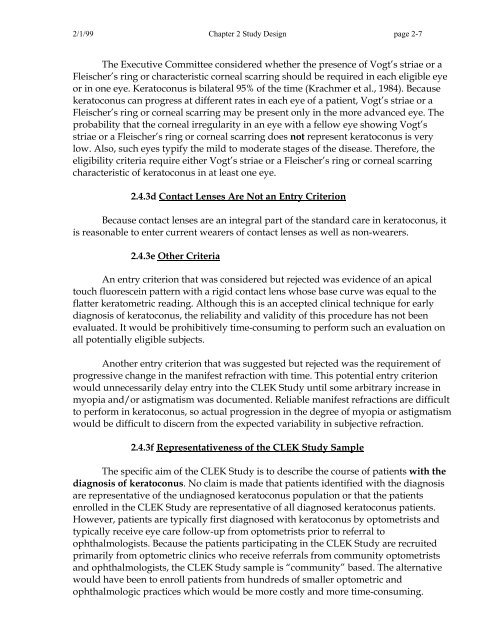OM t of c.iii - Vision Research Coordinating Center - Washington ...
OM t of c.iii - Vision Research Coordinating Center - Washington ...
OM t of c.iii - Vision Research Coordinating Center - Washington ...
Create successful ePaper yourself
Turn your PDF publications into a flip-book with our unique Google optimized e-Paper software.
2/1/99 Chapter 2 Study Design page 2-7<br />
The Executive Committee considered whether the presence <strong>of</strong> Vogt’s striae or a<br />
Fleischer’s ring or characteristic corneal scarring should be required in each eligible eye<br />
or in one eye. Keratoconus is bilateral 95% <strong>of</strong> the time (Krachmer et al., 1984). Because<br />
keratoconus can progress at different rates in each eye <strong>of</strong> a patient, Vogt’s striae or a<br />
Fleischer’s ring or corneal scarring may be present only in the more advanced eye. The<br />
probability that the corneal irregularity in an eye with a fellow eye showing Vogt’s<br />
striae or a Fleischer’s ring or corneal scarring does not represent keratoconus is very<br />
low. Also, such eyes typify the mild to moderate stages <strong>of</strong> the disease. Therefore, the<br />
eligibility criteria require either Vogt’s striae or a Fleischer’s ring or corneal scarring<br />
characteristic <strong>of</strong> keratoconus in at least one eye.<br />
2.4.3d Contact Lenses Are Not an Entry Criterion<br />
Because contact lenses are an integral part <strong>of</strong> the standard care in keratoconus, it<br />
is reasonable to enter current wearers <strong>of</strong> contact lenses as well as non-wearers.<br />
2.4.3e Other Criteria<br />
An entry criterion that was considered but rejected was evidence <strong>of</strong> an apical<br />
touch fluorescein pattern with a rigid contact lens whose base curve was equal to the<br />
flatter keratometric reading. Although this is an accepted clinical technique for early<br />
diagnosis <strong>of</strong> keratoconus, the reliability and validity <strong>of</strong> this procedure has not been<br />
evaluated. It would be prohibitively time-consuming to perform such an evaluation on<br />
all potentially eligible subjects.<br />
Another entry criterion that was suggested but rejected was the requirement <strong>of</strong><br />
progressive change in the manifest refraction with time. This potential entry criterion<br />
would unnecessarily delay entry into the CLEK Study until some arbitrary increase in<br />
myopia and/or astigmatism was documented. Reliable manifest refractions are difficult<br />
to perform in keratoconus, so actual progression in the degree <strong>of</strong> myopia or astigmatism<br />
would be difficult to discern from the expected variability in subjective refraction.<br />
2.4.3f Representativeness <strong>of</strong> the CLEK Study Sample<br />
The specific aim <strong>of</strong> the CLEK Study is to describe the course <strong>of</strong> patients with the<br />
diagnosis <strong>of</strong> keratoconus. No claim is made that patients identified with the diagnosis<br />
are representative <strong>of</strong> the undiagnosed keratoconus population or that the patients<br />
enrolled in the CLEK Study are representative <strong>of</strong> all diagnosed keratoconus patients.<br />
However, patients are typically first diagnosed with keratoconus by optometrists and<br />
typically receive eye care follow-up from optometrists prior to referral to<br />
ophthalmologists. Because the patients participating in the CLEK Study are recruited<br />
primarily from optometric clinics who receive referrals from community optometrists<br />
and ophthalmologists, the CLEK Study sample is “community” based. The alternative<br />
would have been to enroll patients from hundreds <strong>of</strong> smaller optometric and<br />
ophthalmologic practices which would be more costly and more time-consuming.
















